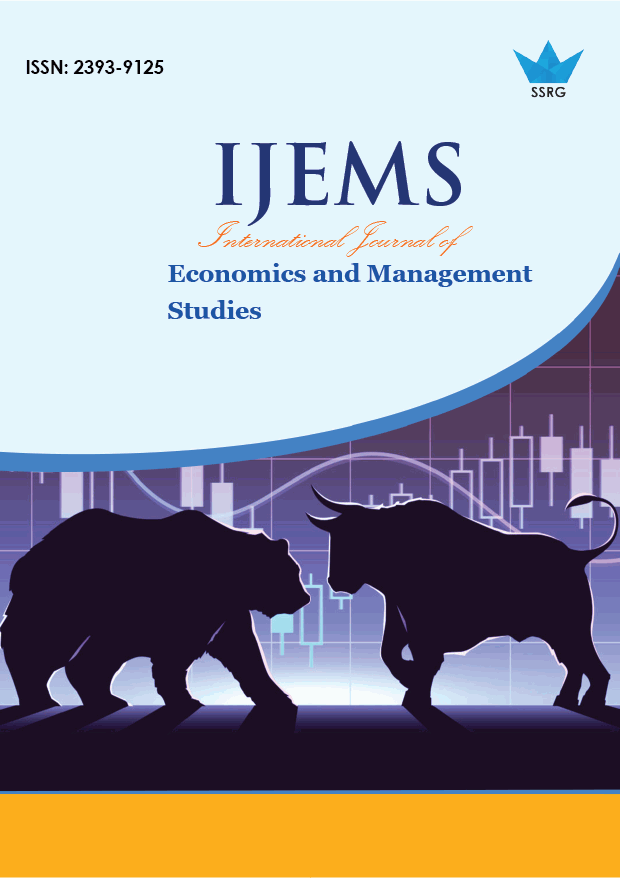Female Labour Force Participation in India: The Post 2017 Turnaround

| International Journal of Economics and Management Studies |
| © 2025 by SSRG - IJEMS Journal |
| Volume 12 Issue 9 |
| Year of Publication : 2025 |
| Authors : Arsh Pandey |
How to Cite?
Arsh Pandey, "Female Labour Force Participation in India: The Post 2017 Turnaround," SSRG International Journal of Economics and Management Studies, vol. 12, no. 9, pp. 80-89, 2025. Crossref, https://doi.org/10.14445/23939125/IJEMS-V12I9P108
Abstract:
Trends in the Female Labour Force Participation Rate (LFPR) in India have been inconsistent, ranging from constant declines in the early 2000s to rapid increases in the late 2010s. Using data from the Periodic Labour Force Survey (PLFS) and National Sample Survey (NSS), this paper examined the reversal in female LFPR in India, highlighting the post-2017 rise in contrast to the preceding period marked by a consistent decline. Trend analysis and correlation analysis were applied to identify the possible factors and their relationship with female LFPR. The findings showed that between 2017–18 and 2023–24, male LFPR rose by 2.7%, while female LFPR grew much faster, increasing by 14.2%. Moreover, in 2017, female LFPR reversed its declining trend at 17.5% and began rising, reaching 31.7% by 2023-24. By examining the industry-specific data, the study found an agriculture-focused shift among women in India. Furthermore, by examining employment type and income, the majority of the increasing female LFPR can be attributed to economic distress caused by the COVID-19 pandemic, which forced women into work. Subsequently, improved survey methodologies of the PLFS and multiple educational policies promoting working women contributed to this trend. Additionally, it was identified that most of the increase in female workers was in informal, unpaid, and self-employed roles. Therefore, these findings support the hypothesis that the increase in female LFPR results from economic compulsion rather than increased employment opportunities for women in India.
Keywords:
Female, LFPR, Policies, Education, COVID, Industries.
References:
[1] Government of India, Ministry of Statistics and Programme Implementation (MoSPI), Periodic Labour Force Survey (PLFS) Annual Reports, 2018–2024. [Online]. Available: https://www.mospi.gov.in/Periodic-Labour-Surveys
[2] Steven Kapsos, Andrea Silberman, and Evangelia Bourmpoula, Why is Female Labour Force Participation Declining so Sharply in India?, ILO Research Paper, Geneva: ILO, pp. 1-59, 2014.
[Google Scholar] [Publisher Link]
[3] Jonathan David Ostry et al., Economic Gains from Gender Inclusion: New Evidence, IMF Staff Discussion Note SDN/18/06, Washington, DC: International Monetary Fund, 2018.
[Google Scholar] [Publisher Link]
[4] The Code on Wages, in the Gazette of India Extraordinary, 2019. [Online]. Available: https://labour.gov.in/sites/default/files/the_code_on_wages_2019_no._29_of_2019.pdf
[5] Santosh Mehrotra, The Indian Labour Market: A Fallacy, Two Looming Crises and a Tragedy, CSE Working Paper, 2018. [Online]. Available: https://publications.azimpremjiuniversity.edu.in/4330/1/Mehrotra_Indian_Labour_Market_April2018.pdf
[6] Ashwini Deshpande, “The Covid-19 Pandemic and Gendered Division of Paid Work, Domestic Chores and Leisure: Evidence from India’s First Wave,” Economia Politica, vol. 39, no. 1, pp. 75-100, 2021.
[CrossRef] [Google Scholar] [Publisher Link]
[7] Surjit S. Bhalla, and Ravinder Kaur, Labour Force Participation of Women in India: Some Facts, Some Queries, Asia Research Centre Working Paper No. 40, London School of Economics, 2011.
[Google Scholar] [Publisher Link]
[8] Kuhu Joshi, Avinash Kishore, and Chaitanya K. Joshi, Women’s Labor Force Participation in Rural India: Trends and Factors,International Food Policy Research Institute, 2019. [Online]. Available: https://research.aciar.gov.au/sdip/wp content/uploads/2023/03/StatusReportWomensLabourForceParticipationinIndia.pdf
[9] Ajad Singh, and Amrat Lal Meena, “Exploring Trends and Factors Influencing Labour Force Participation in Uttarakhand: Evidence from NSSO Data,” International Journal of Research Publication and Reviews, vol. 4, no. 6, pp. 524-532, 2023.
[Google Scholar] [Publisher Link]
[10] Priyal Saini, “Employment Matters: Salient Barriers to Women’s Labor Force Participation in India,” International Journal of Social Science and Economic Research, vol. 08, no. 08, pp. 2221-2228, 2023.
[CrossRef] [Google Scholar] [Publisher Link]
[11] S. Deshpande, Social Identities and Female Labour Force Participation in India, 2021. [Online]. Available: https://iwwage.org/wp content/uploads/2021/12/Social-Identities-and-Female-Labour-Force-Brief.pdf
[12] Key Indicators of Employment and Unemployment in India 2011-2012. [Online]. Available: https://www.mospi.gov.in/sites/default/files/publication_reports/KI-68th-E&U-PDF.pdf
[13] Government of India, Beti Bachao, Beti Padhao Scheme Guidelines, Ministry of Women and Child Development, Government of India, 2015.
[Publisher Link]
[14] Ministry of Education, Samagra Shiksha – An Integrated Scheme for School Education, Department of School Education & Literacy, Government of India, 2018. [Publisher Link]
[15] Ministry of Education, Kasturba Gandhi Balika Vidyalaya (KGBV) Scheme Annual Report, Department of School Education & Literacy, Government of India, 2021.
[Publisher Link]
[16] Ministry of Rural Development, Participation of Rural Women in MGNREGA, 2021–22, Press Information Bureau, Government of India, 2022.
[Publisher Link]
[17] Ministry of Finance, Economic Survey of India, Government of India, 2022-2023.
[Publisher Link]
[18] International Labour Organization and Institute for Human Development, India Employment Report 2024.
[Publisher Link]
[19] Prime Minister Narendra Modi, New Labour Code for new India, In New Labour Code for New India, 2020. [Online]. Available: https://labour.gov.in/sites/default/files/labour_code_eng.pdf
[20] Ministry of Labour and Employment (2019-2020), The Code on Wages (2019), The Code on Social Security (2020), The Occupational Safety, Health and Working Conditions Code (2020), Government of India. [Online]. Available: https://labour.gov.in/labour-codes
[21] National Sample Survey Office, 68th Round Employment–Unemployment Survey 2011-12, Government of India, 2014. [Online]. Available: https://mospi.gov.in/sites/default/files/publication_reports/nss_rep_563_13mar15.pdf
[22] Down and Out? The Gendered Impact of the COVID-19 Pandemic on India’s Labour Market, CSE Working Paper, 2021. [Online]. Available: https://publications.azimpremjiuniversity.edu.in/4303/1/Abraham_Basole_Kesar_Gender_Covid_Feb_2021.pdf
[23] National Statistical Office, Time Use Survey 2019, MoSPI, Government of India, 2020. [Online]. Available: https://mospi.gov.in/time-use-survey
[24] Shikha Dube, and Reenu Bairagi, “Analyzing How Women Workers In Informal Sector Are Vulnerable To Exploitation And Their Legal Protection,” International Journal of Legal Studies and Social Sciences, vol. 3, no. 2, pp. 625-638, 2025.
[Publisher Link]
[25] World Bank, Girls’ Education, Washington, DC: World Bank, 2023. [Online]. Available: https://www.worldbank.org/en/topic/girlseducation
[26] Ministry of Rural Development, Annual Report on Mahatma Gandhi National Rural Employment Guarantee Act (MGNREGA), 2021–22, Government of India, 2022. [Online]. Available:https://nrega.dord.gov.in/MGNREGA_new/Nrega_home.aspx
[27] Indiagraphy, Arunachal Pradesh, 2023. [Online]. Available: https://indiagraphy.com/arunachal-pradesh.html

 10.14445/23939125/IJEMS-V12I9P108
10.14445/23939125/IJEMS-V12I9P108